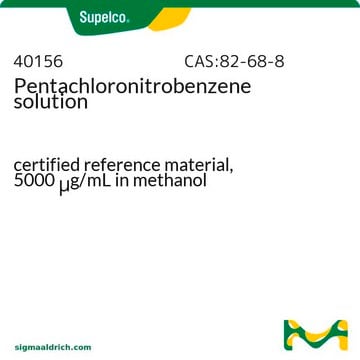If this product has an expiration or retest date, it will be shown on the Certificate of Analysis (COA, CofA). If there is no retest or expiration date listed on the product's COA, we do not have suitable stability data to determine a shelf life. For these products, the only date on the COA will be the release date; a retest, expiration, or use-by-date will not be displayed.
For all products, we recommend handling per defined conditions as printed in our product literature and website product descriptions. We recommend that products should be routinely inspected by customers to ensure they perform as expected.
For products without retest or expiration dates, our standard warranty of 1 year from the date of shipment is applicable.
For more information, please refer to the Product Dating Information document: https://www.sigmaaldrich.com/deepweb/assets/sigmaaldrich/marketing/global/documents/449/386/product-dating-information-mk.pdf
P2205
Pentachloronitrobenzene
≥94%
Synonym(s):
PCNB, Quintozene
Select a Size
Select a Size
About This Item
Recommended Products
assay
≥94%
95%
mp
140-143 °C (lit.)
SMILES string
[O-][N+](=O)c1c(Cl)c(Cl)c(Cl)c(Cl)c1Cl
InChI
1S/C6Cl5NO2/c7-1-2(8)4(10)6(12(13)14)5(11)3(1)9
Inchi Key
LKPLKUMXSAEKID-UHFFFAOYSA-N
Looking for similar products? Visit Product Comparison Guide
Related Categories
Application
<li><strong>Pentachloronitrobenzene Environmental Impact:</strong> Pentachloronitrobenzene (PCNB) is an organochlorine fungicide widely used for seed and soil treatments to control various fungal pathogens and also disrupts murine ventricular wall development by inhibiting cardiomyocyte proliferation, highlighting its significant biological impact and raising concerns about its environmental safety (Gao et al., 2024).</li>
</ul>
signalword
Warning
hcodes
Hazard Classifications
Acute Tox. 4 Oral - Aquatic Acute 1 - Aquatic Chronic 1 - Skin Sens. 1
Storage Class
11 - Combustible Solids
wgk_germany
WGK 2
flash_point_f
Not applicable
flash_point_c
Not applicable
ppe
dust mask type N95 (US), Eyeshields, Faceshields, Gloves
Choose from one of the most recent versions:
Certificates of Analysis (COA)
Don't see the Right Version?
If you require a particular version, you can look up a specific certificate by the Lot or Batch number.
Already Own This Product?
Find documentation for the products that you have recently purchased in the Document Library.
Customers Also Viewed
-
How can I determine the shelf life / expiration / retest date of this product?
1 answer-
Helpful?
-
-
How is shipping temperature determined? And how is it related to the product storage temperature?
1 answer-
Products may be shipped at a different temperature than the recommended long-term storage temperature. If the product quality is sensitive to short-term exposure to conditions other than the recommended long-term storage, it will be shipped on wet or dry-ice. If the product quality is NOT affected by short-term exposure to conditions other than the recommended long-term storage, it will be shipped at ambient temperature. As shipping routes are configured for minimum transit times, shipping at ambient temperature helps control shipping costs for our customers. For more information, please refer to the Storage and Transport Conditions document: https://www.sigmaaldrich.com/deepweb/assets/sigmaaldrich/marketing/global/documents/316/622/storage-transport-conditions-mk.pdf
Helpful?
-
-
Does this product (pentachloronitrobenzene) dissolve in water or is another diluent necessary?
1 answer-
This product has a very limited water solubility. It is not advisable to use water as a solvent for this compound. Instead, it is soluble in methanol and potentially other organic solvents. Please check the references below:_x000D_
https://pubs.acs.org/doi/10.1021/jf061673p_x000D_
https://pubs.acs.org/doi/10.1021/es050407%2BHelpful?
-
Active Filters
Our team of scientists has experience in all areas of research including Life Science, Material Science, Chemical Synthesis, Chromatography, Analytical and many others.
Contact Technical Service












